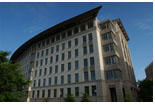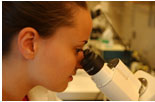Overview
Links
The Program in Microbiology and Molecular Genetics provides training in the study of microorganisms as well as in the use of microbial models to investigate basic problems in molecular genetics. The program is designed not only for students interested in academic careers in teaching and research, but also for those interested in careers in related aspects of medicine and industry. Research training is offered in bacterial genetics and physiology, microbial development, molecular biology of viruses and bacterial pathogens, molecular biology of DNA replication, recombination and transposition.
Educational and Research Opportunities
The graduate experience in the Microbiology and Molecular Genetics Program (MMG) begins with an introduction to the faculty, current students, and their research through a series of short talks, discussions, and a poster session. The students then choose the first of three research rotations which are designed to give the student exposure to various research areas and techniques before choosing a direction and laboratory for their thesis research. In the first and second years, students also participate in courses which prepare them for analyzing, critiquing, and presenting research in the areas of bacterial genetics, biochemistry, microbial pathogenesis, molecular genetics in eukaryotic and prokaryotic systems, immunology, and molecular mechanisms for DNA rearrangements and gene regulation.
MMG graduate students are afforded the opportunity to teach for one semester in their second year; all students are prepared for this experience by attending a symposium on teaching strategies, techniques, and ethics. Journal clubs, seminars, and attending international meetings contribute to the graduate educational experience. Students usually complete their graduate work in four to five years and then move on to excellent postdoctoral positions enroute to academic, industry, and government research positions.
Research Environment
The research environment in Microbiology and Molecular Genetics is strongly interactive among different laboratories. There is Core support from the University for key technologies, including protein analysis, bioinformatics, and molecular modeling, electron and confocal microscopy, and a transgenic mouse facility. An NIH Training Grant has been awarded to us to train pre-and post-doctoral students in Molecular Mechanisms of Microbial Pathogenesis.
The research groups in the MMG Program are supportive of one another and students in the Program profit from the advice of faculty and postdoctoral associates in many different laboratories. Because the Program is Interdepartmental, it benefits from faculty with different backgrounds and the research labs are located at the main University campus, the Vaccine Center on the nearby Emory National Primate Research Center, the Veterans Administration Hospital facility, and the Centers for Disease Control and Prevention (CDC). All buildings are within a 15-minute walk of each other and are connected by shuttle bus service.

Campus Life
Located just 15 minutes from downtown Atlanta in the tree-lined suburban neighborhood of Druid Hills, Emory University is positioned along the Clifton Corridor, which also includes the U.S. Centers for Disease Control and Prevention and the American Cancer Society.
Emory University is home to nine major academic divisions, numerous centers for advanced study, and a host of prestigious affiliated institutions. In addition to Emory College, the University encompasses a graduate school of arts and sciences; professional schools of medicine, theology, law, nursing, public health, and business; and Oxford College, a two-year undergraduate division on the original campus of Emory in Oxford, Ga.
Emory was founded at Oxford by the Methodist Church in 1836. The University has 11,300 students and 2,500 faculty members who represent all regions of the United States and more than 100 foreign nations.
